
Chapter 8: Assessing a New Venture’s Financial Strength and Viability
CHAPTER 8
ASSESSING A NEW VENTURE’S FINANCIAL
STRENGTH AND VIABILITY
LEARNING OBJECTIVES
7.
Explain the purpose of pro forma financial statements.
CHAPTER OVERVIEW
This chapter focuses on the important task of assessing a new venture’s financial strength
and viability. For the purpose of completeness, we look at how both existing ventures and
start-up firms assess their financial strength and viability.
In the first section of the chapter, we focus on general financial management and discuss
the financial objectives of a firm, which include profitability, liquidity, efficiency, and
stability. We then articulate the steps involved in the financial management process. The
second section of the chapter focuses on the development of historical financial

Chapter 8: Assessing a New Venture’s Financial Strength and Viability
5. Comparing a Firm’s Financial Results to Industry Norms
V. Forecasts
A. Sales Forecast
B. Forecast of Costs of Sales and Other Items
VI. Pro Forma Financial Statements
A. Pro Forma Income Statement
B. Pro Forms Balance Sheet
C. Pro Forma Statement of Cash Flows
D. Ratio Analysis
CHAPTER NOTES
I. Introduction to Financial Management
A. Financial management deals with two things: raising money and managing a
company’s finances in a way that achieves the highest rate of return.
B. We cover the process of raising money in Chapter 10. This chapter focuses on
how a company manages its finances in an effort to increase its financial strength
and earn the highest rate of return.
C. The financial management of a firm deals with questions such as the following on
an ongoing basis:
a. How are we doing? Are we making or losing money?
b. How much cash do we have on hand?
c. Do we have enough cash to meet our short-term obligations?
d. How efficiently are we utilizing our assets?
e. How do our growth and net profits compare to those of our industry peers?
f. Where will the funds we need for capital improvements come from?
g. Are there ways we can partner with other firms to share risk and reduce the
amount of cash we need?
h. Overall, are we in good shape financially?
D. A properly managed firm stays on top of these questions through the tools and
techniques that are discussed in this chapter.
II. Financial Objectives of a Firm
A. Profitability is the ability to earn a profit.
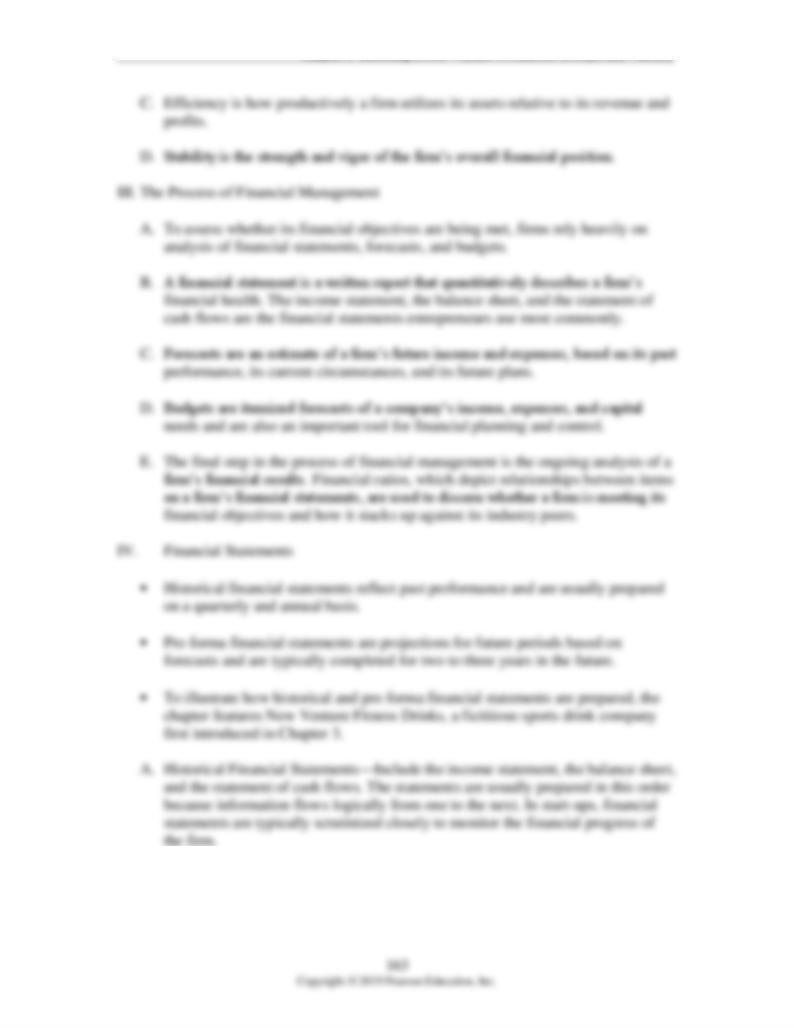
Chapter 8: Assessing a New Venture’s Financial Strength and Viability
1. Income Statement. The income statement reflects the results of the operations
of a firm over a specified period of time. It records all the revenues and
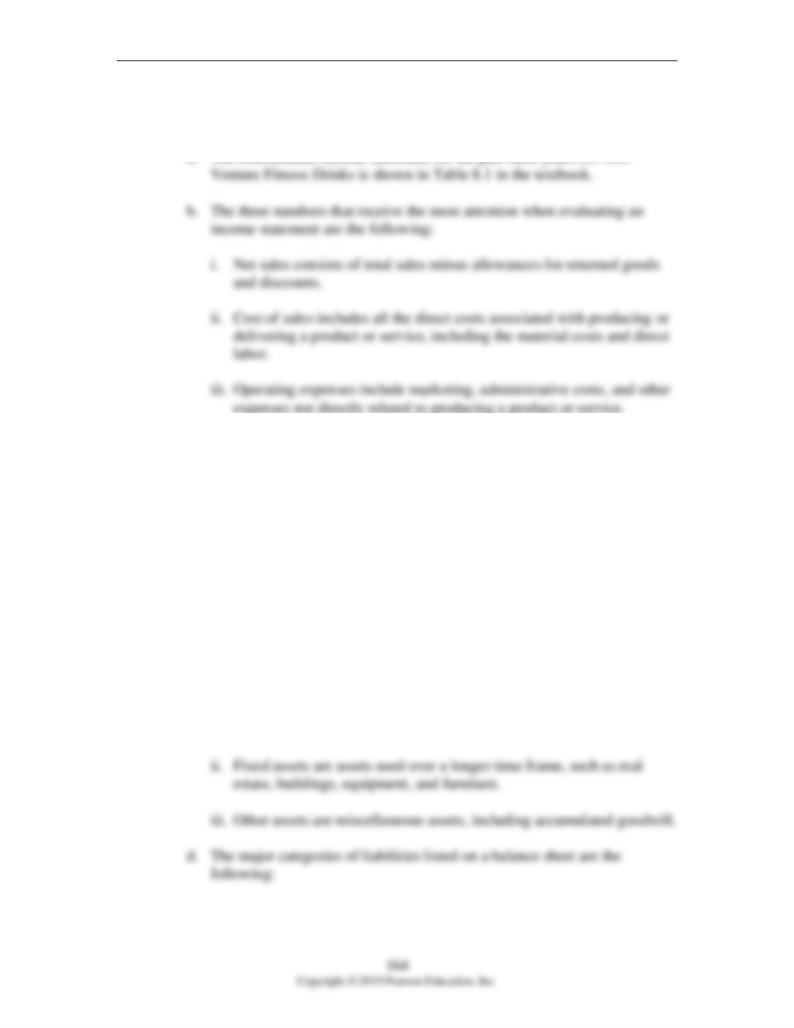
Chapter 8: Assessing a New Venture’s Financial Strength and Viability
expenses for the given period and shows whether the firm is making a profit
or is experiencing a loss.
2. Balance Sheet. Unlike the income statement, which covers a specified period
of time, a balance sheet is a snapshot of a company’s assets, liabilities, and
owners’ equity at a specified point in time.
a. The left-hand side of a balance sheet (or the top, depending on how it is
displayed) shows a firm’s assets, while the right-hand side (or bottom)
shows its liabilities and owners’ equity.
b. The consolidated balance sheet for New Venture Fitness Drinks is shown
in Table 8.2 in the textbook. Multiple years are shown so trends can be
easily spotted.
c. The major categories of assets listed on a balance sheet are the following:
i. Current assets include cash plus items that are readily convertible to
cash, such as accounts receivable, marketable securities, and
inventories.
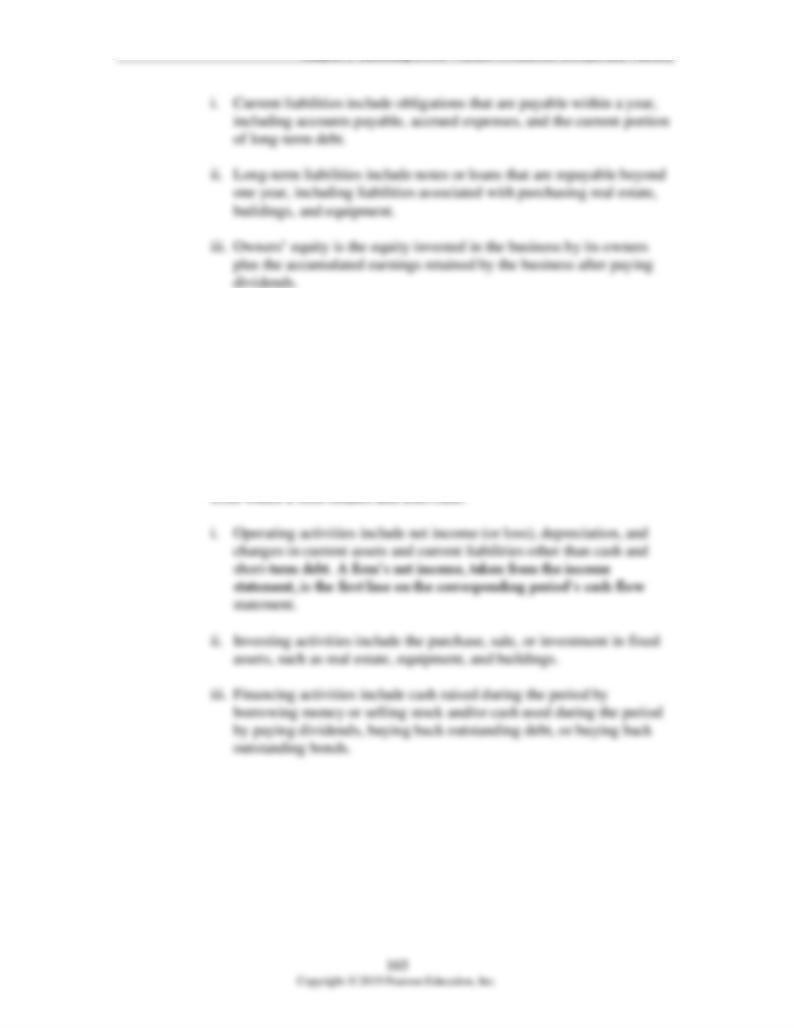
Chapter 8: Assessing a New Venture’s Financial Strength and Viability
3. Statement of Cash Flows. The statement of cash flows summarizes the
changes in a firm’s cash position for a specified period of time and details
why the changes occurred. It is similar to a month-end bank statement. It
reveals how much cash is on hand at the end of the month as well as how the
cash was acquired and spent during the month.
a. The statement of cash flows is divided into three separate activities:
operating activities, investing activities, and financing activities.
b. These activities, which are explained in the following list, are the activities
Table 8.3 in the textbook. As a management tool, it is intended to provide
perspective on the following questions:
i. Is the firm generating excess cash that could be used to pay down debt
or be returned to stockholders in the form of dividends?

Chapter 8: Assessing a New Venture’s Financial Strength and Viability
ii. Is the firm generating enough cash to fund its investments from
earnings, or is it relying on lenders or investors?
4. Ratio Analysis. The most practical way to interpret or make sense of a firm’s
historical financial statement is through ratio analysis. Table 8.4 in the
5. Comparing a Firm’s Financial Results to Industry Norms. Comparing its
financial results to industry norms helps a firm determine how it stacks up
against its competitors and if there are any financial “red flags” requiring
attention.
V. Forecasts
1. Once a firm has completed its sales forecast, it must forecast the costs of sales
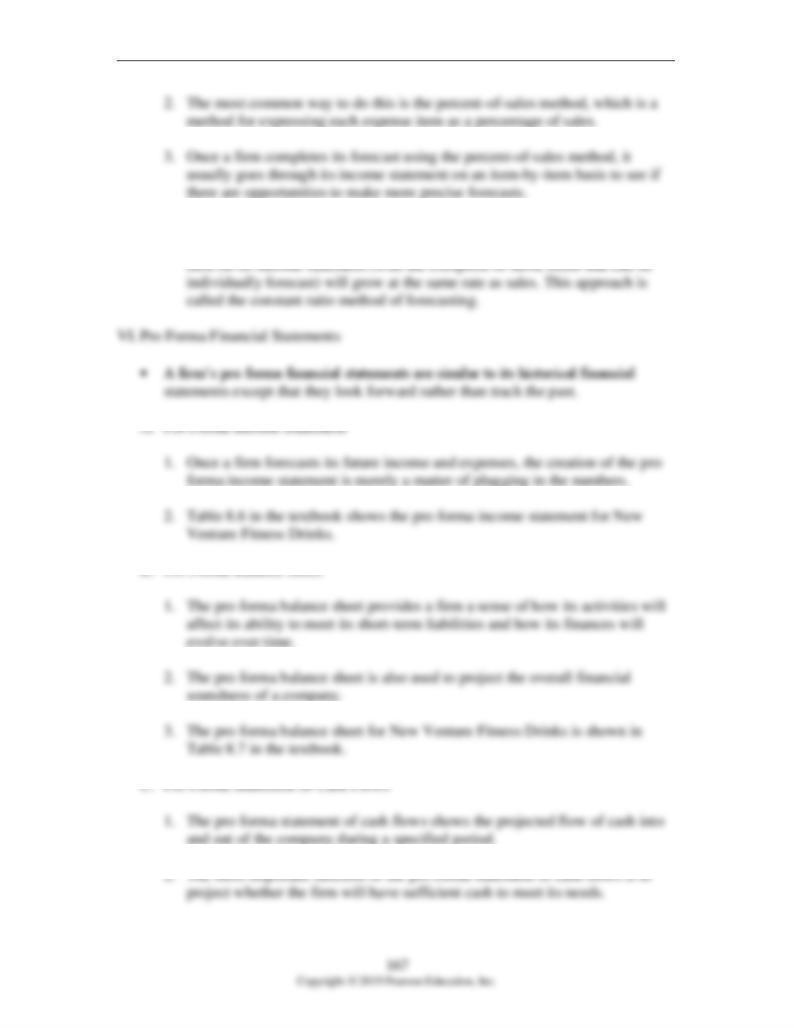
Chapter 8: Assessing a New Venture’s Financial Strength and Viability
4. If a firm determines that it can use the percent-of-sales method and it follows
the procedure described in the chapter, then the net result is that each expense
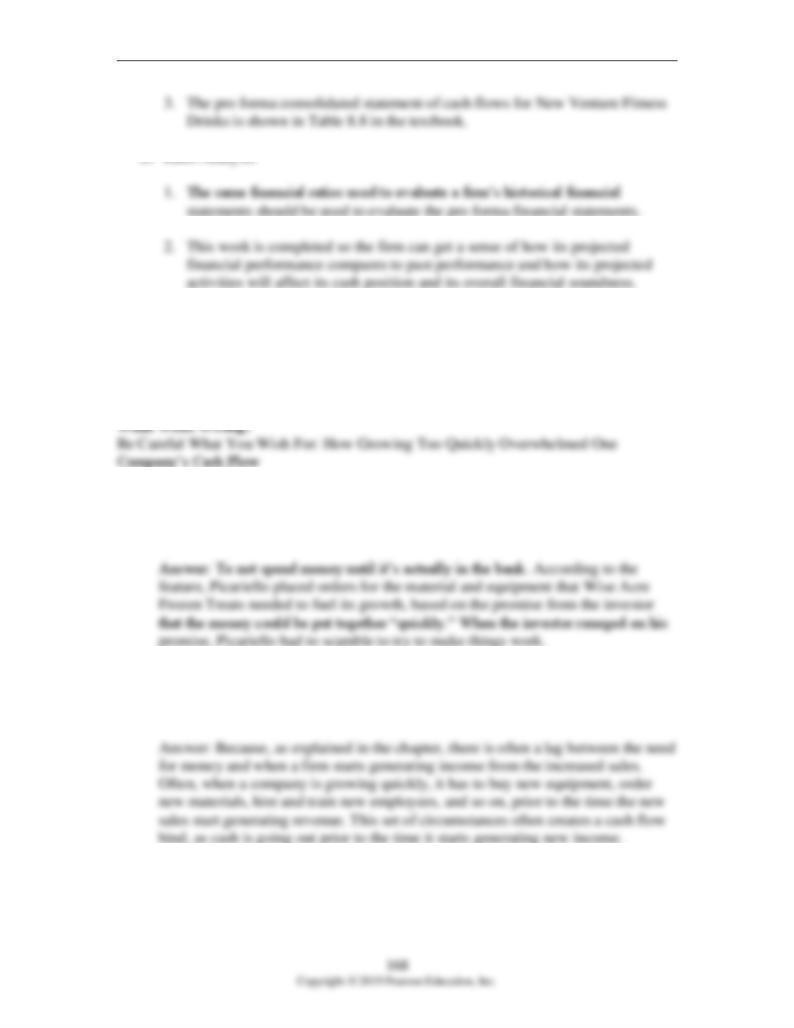
Chapter 8: Assessing a New Venture’s Financial Strength and Viability
3. The historical financial ratios and projected ratios for New Venture Fitness
Drinks are shown in Table 8.9 in the textbook.
BOXED FEATURES: QUESTIONS FOR CRITICAL THINKING
1.
What lessons can be learned from Jim Picariello’s agreement with the high net
worth individual, who agreed to invest $1 million in Wise Acre Frozen Treats and
then reneged on the agreement when the economy turned sour?
2.
Why is it that a company can grow too fast? If Wise Acre Frozen Treats
significantly increased its sales, why wouldn’t its increased income provide more
than enough cash to even out its cash flow?
3.
Besides cash flow difficulties, what other problems can a firm experience by
growing too quickly?
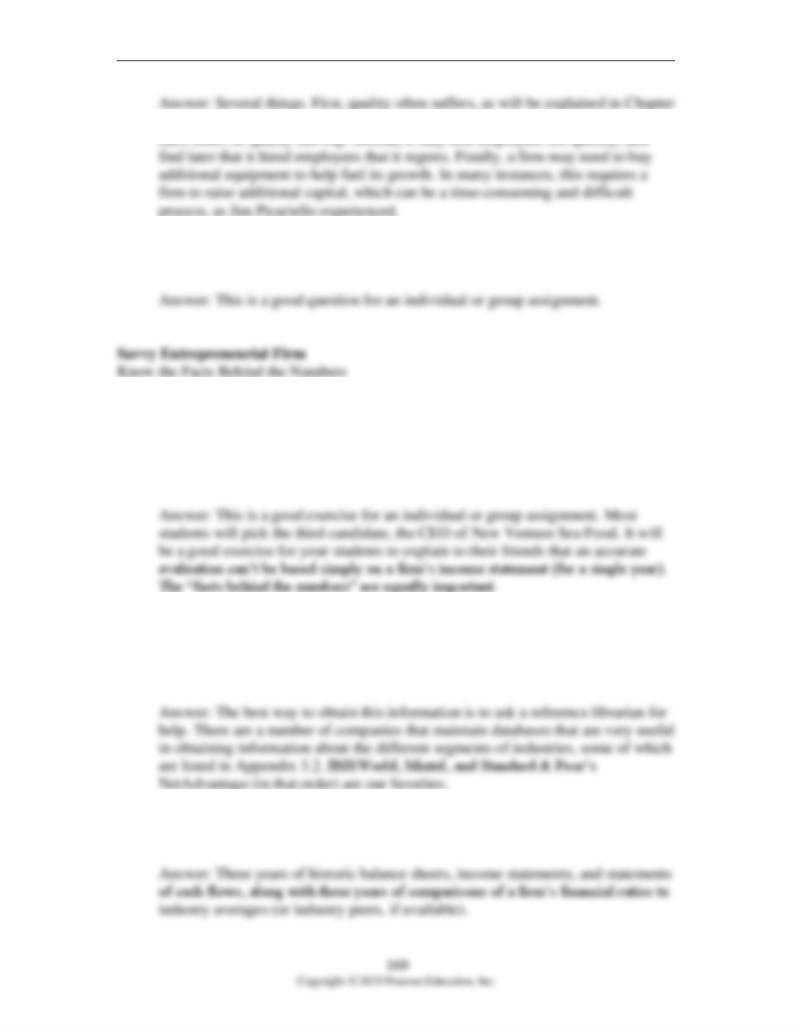
Chapter 8: Assessing a New Venture’s Financial Strength and Viability
13. As a firm’s pace of activity quickens, it invariably can’t spend as much time on
4.
If Jim Picariello starts another company, make a list of the things you think he’ll
do differently as a result of his Wise Acre Frozen Treats experience.
1.
Show the income statements for the three candidates to two or three friends who
are majoring in business. Ask them to select the best CEO from among these three
people on the basis of these income statements. In addition, ask your friends to
explain their choices to you. Did your friends choose the same candidate? If not,
what do you think caused the differences in their choices?
2.
Based on material presented in this chapter, earlier chapters in the book, and your
general business knowledge, where would you go to find information about the
growth of the different segments of the restaurant industry? Where would you go
to find information about the profitability of the restaurant industry in general?
3.
What would have been the appropriate financial information to request from the
three candidates for the job?
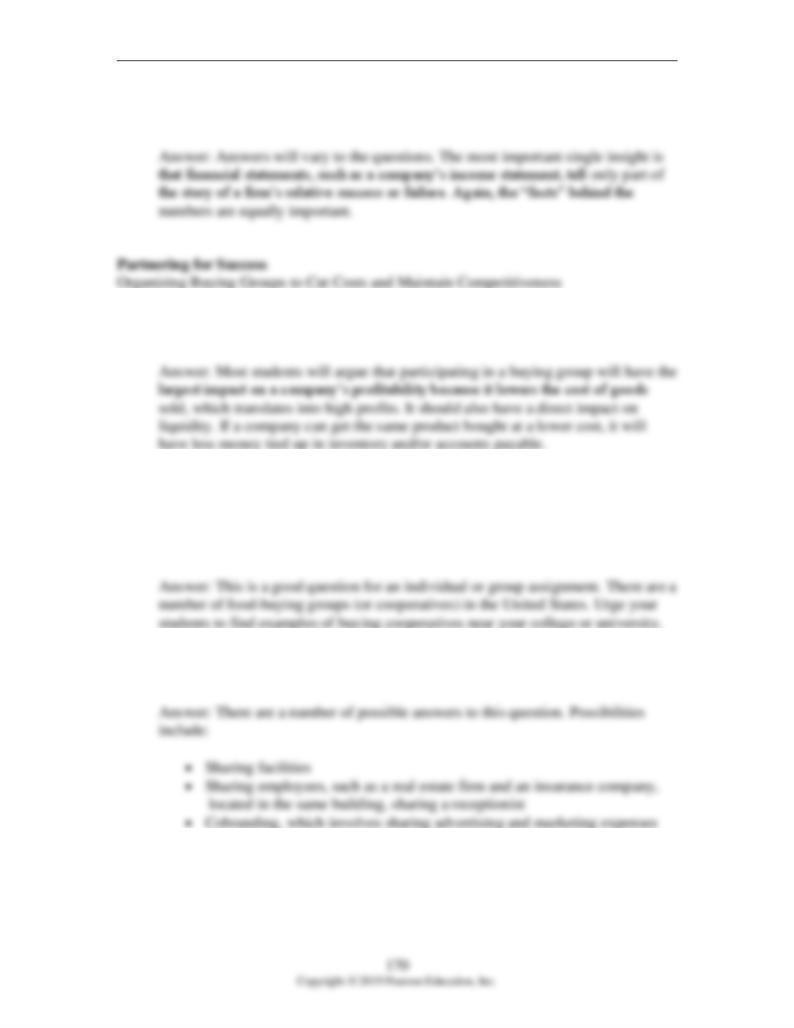
Chapter 8: Assessing a New Venture’s Financial Strength and Viability
4.
What are the three most important insights you gained from studying this feature?
Which of these insights surprised you, and why?
1.
Which of the four financial objectives of a firm, profitability, liquidity, efficiency,
and stability, does participating in a buying cooperative contribute to the most?
2.
Do some Internet and/or library research to try to discern whether there is a small
business buying group or groups that New Venture Fitness Drinks, the fictitious
company introduced in Chapter 3 and used as an example throughout this chapter,
could benefit from. New Venture Fitness Drinks’ products contain all the
ingredients used to make smoothies and similar fitness drinks and shakes.
3.
Identify three ways, other than buying cooperatives, that small businesses partner
with other small businesses to cut costs without sacrificing their competitiveness.
4.
In an effort to improve the financial position of their firms, do you think the
majority of entrepreneurs spend an equal amount of time focusing on (1) cost
cutting and (2) increasing revenues? If not, which of the two do you think they
spend more time on and why?
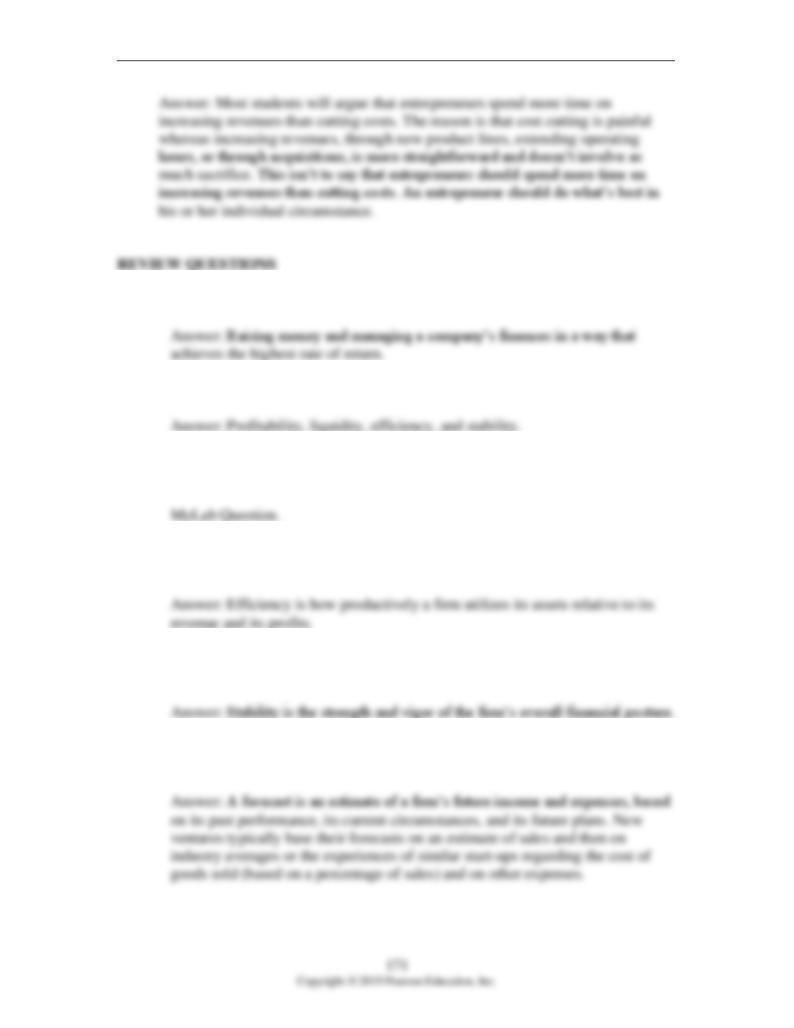
Chapter 8: Assessing a New Venture’s Financial Strength and Viability
8-1.
What are the two primary functions of the financial management of a firm?
8-2.
What are the four main financial objectives of a firm?
8-3.
Why is it important for a company to focus on its liquidity? What special
challenges do entrepreneurial firms have in regard to remaining liquid?
8-4.
What is meant by the term efficiency as it relates to the financial management of
a firm?
8-5.
What is meant by the term stability as it relates to the financial management of a
firm?
8-6.
What is the purpose of a forecast? What factors does a firm use to create its
forecasts of future sales, income, expenses, and capital expenditures?
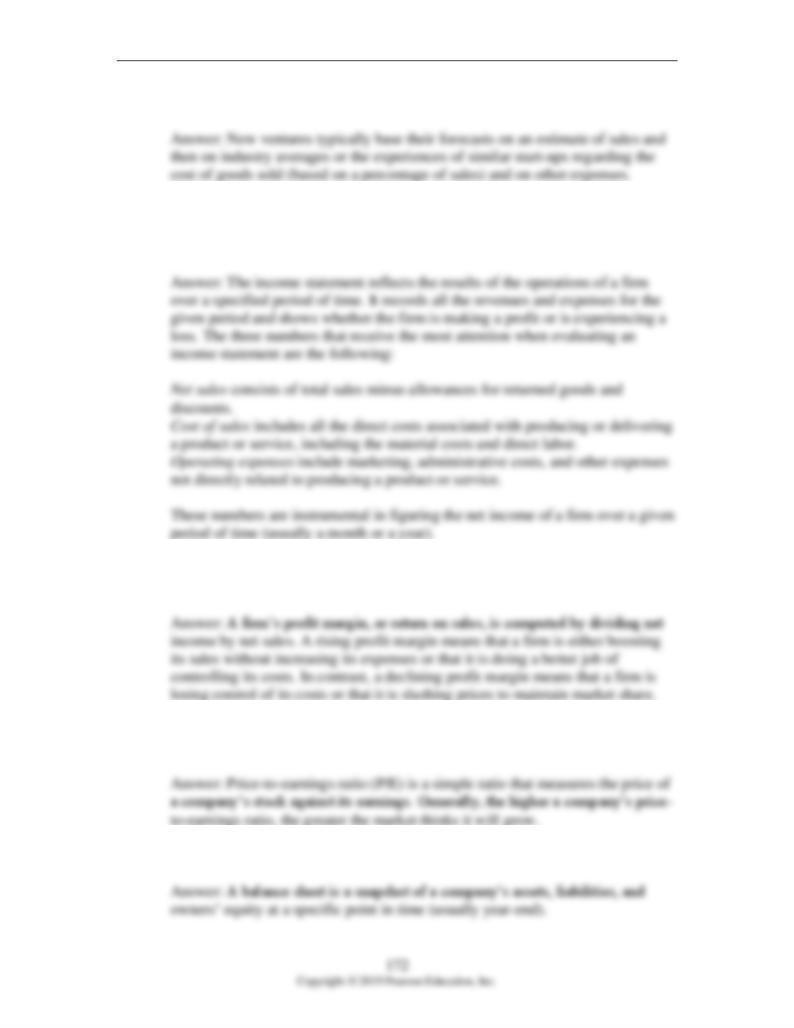
Chapter 8: Assessing a New Venture’s Financial Strength and Viability
8-7.
On what factors or conditions do completely new firms base their forecasts?
8-8.
What is the purpose of an income statement? What are the three numbers that
receive the most attention when evaluating an income statement? Why are these
numbers important?
8-9.
How does a firm compute its profit margin? What is the significance of this
ratio?
8-10.
How does a firm compute its price-to-earnings ratio? Why does a high price-to-
earnings ratio indicate that the stock market thinks the firm will grow?
8-11.
What is the purpose of a balance sheet?

Chapter 8: Assessing a New Venture’s Financial Strength and Viability
8-12.
What are the major categories of assets and liabilities on a balance sheet? Briefly
explain each category.
8-13.
What is meant by the term working capital? Why is working capital an
important consideration for entrepreneurial firms?
8-14.
How does a firm compute its current ratio? Is this a relatively important or
unimportant financial ratio? Explain your answer.
8-15.
What is the purpose of a statement of cash flows?
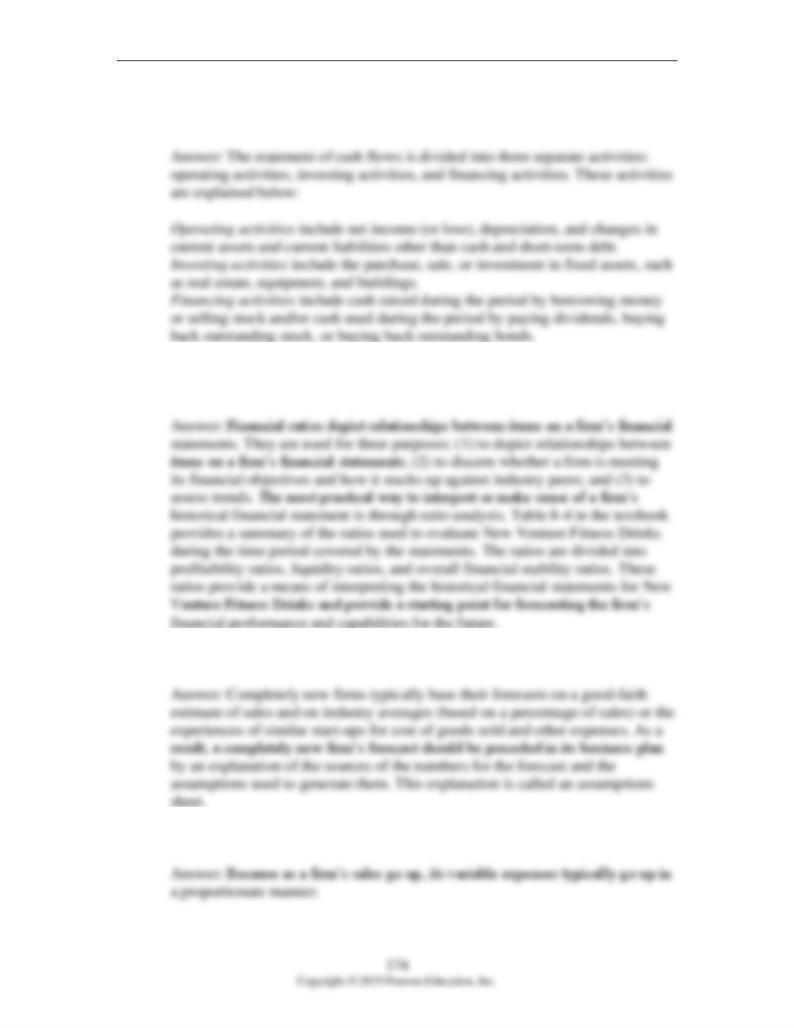
Chapter 8: Assessing a New Venture’s Financial Strength and Viability
8-16.
What are the three separate categories of activities that are reflected on a firm’s
statement of cash flows? Briefly explain the importance of each activity.
8-17.
What is the purpose of financial ratios? Why are financial ratios particularly
useful in helping a firm interpret its financial statements?
8-18.
What is the purpose of an assumptions sheet?
8-19.
Why is a firm’s sales forecast the basis for most of its other forecasts?

Chapter 8: Assessing a New Venture’s Financial Strength and Viability
8-20.
What is meant by the percent-of-sales method as it relates to forecasts?
8-21.
Suppose a friend of yours showed you the pro forma income statements for his
start-up and exclaimed excitedly that during the first three years of operations his
firm will make a net income of $150,000 per year, which is just the amount of
money ($450,000) the firm will need to pay off a three-year loan. Given your
study of the chapter, why is it that your friend may not actually have $450,000 in
cash, even though his pro forma income statements say that he will earn that
amount of money?
8-22.
Kate Snow just retired from a career with Walmart, cashing out a sizable
retirement fund at the time of doing so. To start a second career, she is looking at
the possibility of buying three different businesses. She has three years’
historical financial statements for each business and has been poring over the
numbers. She was puzzled when she read the following statement in a book
about small business financial management: “Be careful when looking at balance
sheets to fully understand what you’re looking at. In some respects balance
sheets are very revealing, and in other respects they can be very deceiving.”
What do you think the author of the book meant by that statement?
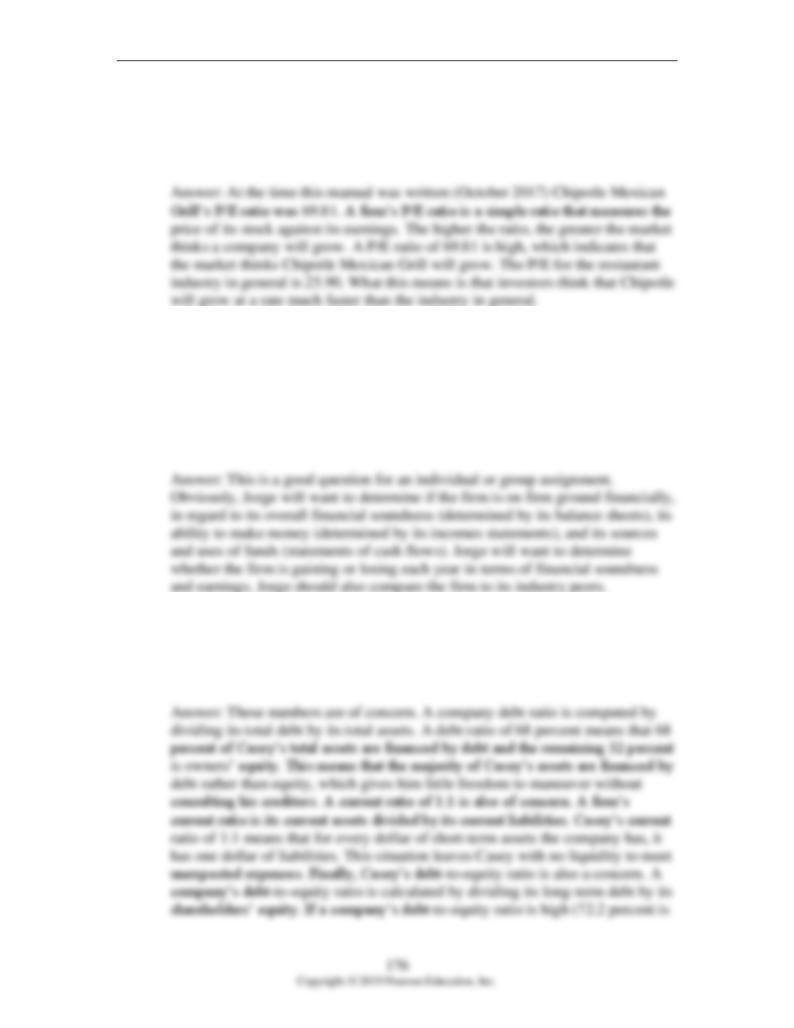
Chapter 8: Assessing a New Venture’s Financial Strength and Viability
8-23.
Chipotle Mexican Grill is a publicly traded company. Calculate the firm’s price-
to-earnings ratio (P/E). What does Chipotle’s P/E ratio tell you about investors’
expectations regarding the company’s growth? How do Chipotle’s financial
ratios compare to restaurant norms at the time of your analysis?
8-24.
Jorge Martinez is thinking about buying an existing printing business and has
been carefully studying the records of the business to get a good handle on its
historical financial performance. Jorge heard that you are taking a class in
entrepreneurship and asks you, “What suggestions do you have for me to make
the best use of this financial information (i.e., three years of audited income
statements, balance sheets, and statements of cash flows)?” What suggestions
would you give Jorge for making the maximum use of the financial statements?
8-25.
Casey Cordell is the owner of a digital photography service in Madison, WI. The
company has been profitable every year of its existence. Its debt ratio is currently
68 percent, its current ratio is 1:1, and its debt-to-equity ratio is 72.2 percent. Do
these financial numbers cause any reason to be concerned? Why or why not?
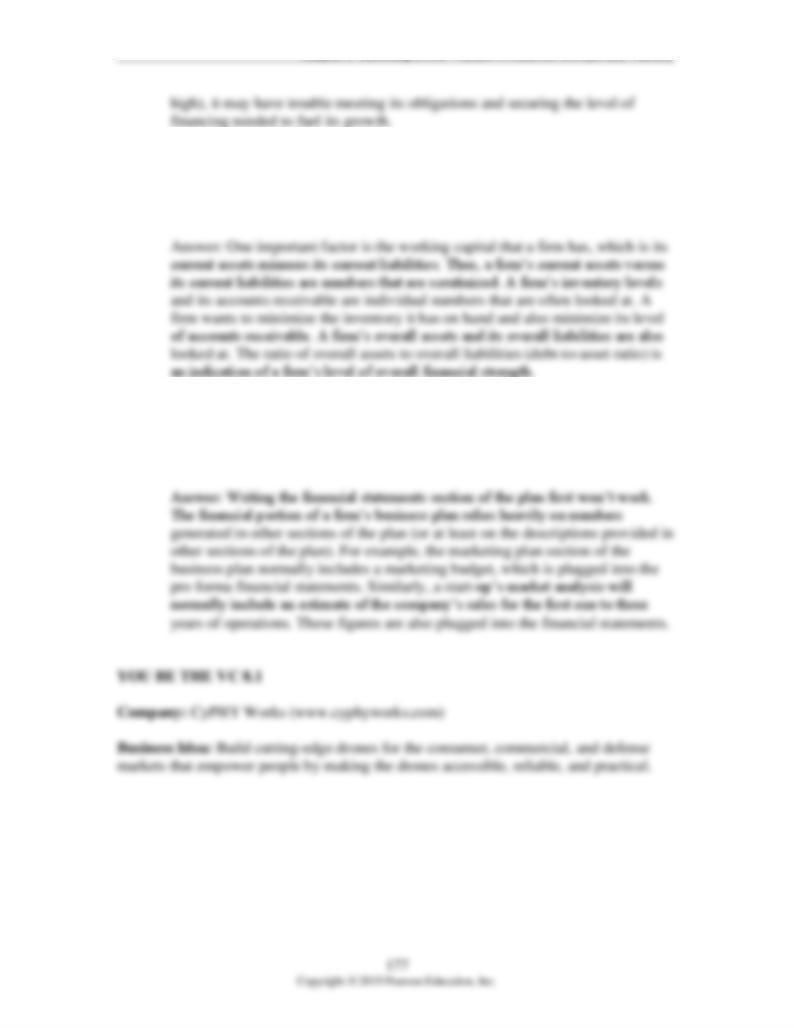
Chapter 8: Assessing a New Venture’s Financial Strength and Viability
8-26.
What items on the left side (or top) and what items on the right side (or bottom)
of a firm’s balance sheet should receive the greatest scrutiny? In regard to each
of these items, what are the most important factors that a new venture should
focus on to maintain its overall financial health?
8-27.
Suppose a colleague of yours is gearing up to write a business plan for a business
she intends to start. She told you she plans to prepare the financial statements
first, to get that job out of the way before she tackles the rest of the plan. What is
the flaw in your colleague’s logic as described to you?
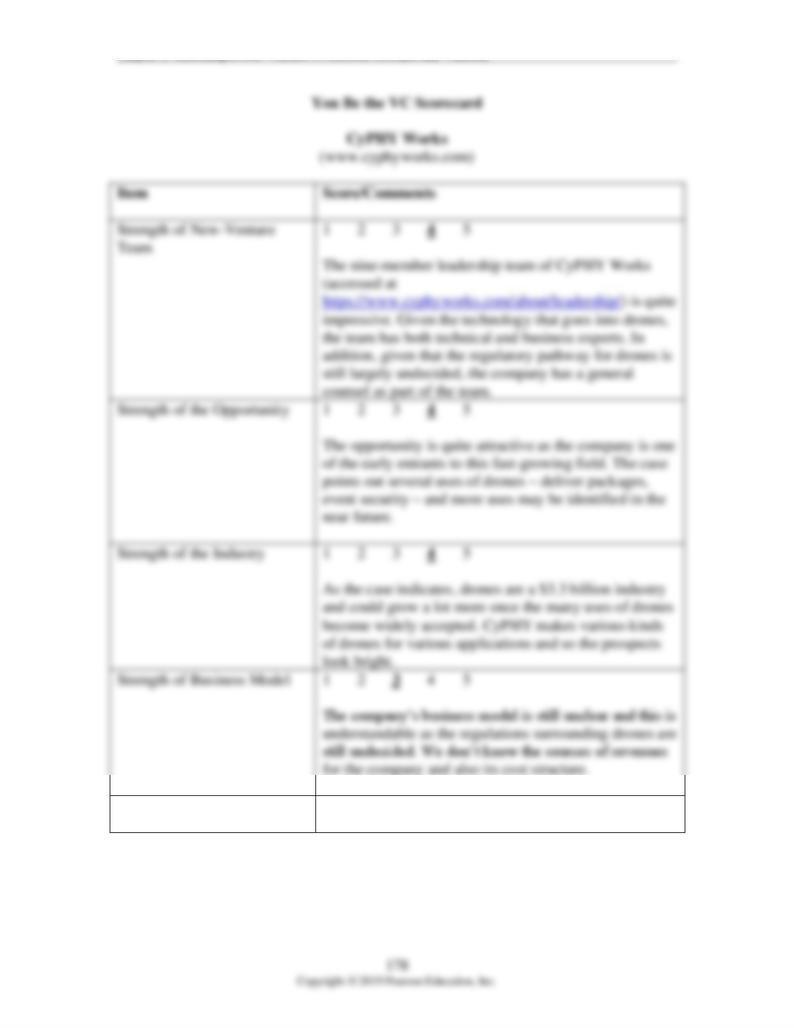
Chapter 8: Assessing a New Venture’s Financial Strength and Viability
Average Score
3.75/5.00
Decision: We would not invest in CyPHY Works. Although we admire the company and
the product they are producing, we don’t know much about the business side of drones
and the cost structure of drone manufacturing and marketing. Perhaps these factors will
become clearer in the future, at which point it may be a good idea to revisit the company.

Chapter 8: Assessing a New Venture’s Financial Strength and Viability
YOU BE THE VC 8.2
Company: nuTonomy (www.nuTonomy.com)
Business Idea: Develop and deploy fully autonomous vehicles.
You Be the VC Scorecard
nuTonomy
(www.nuTonomy.com)
Item
Score/Comments
Strength of New-Venture
Team
1 2 3 4 5
As the case indicates, nuTonomy came out of MIT when
two engineers, Dr. Karl Iagnemma and Dr. Emilio
Frazzoli, co-founded the firm. Since then they have
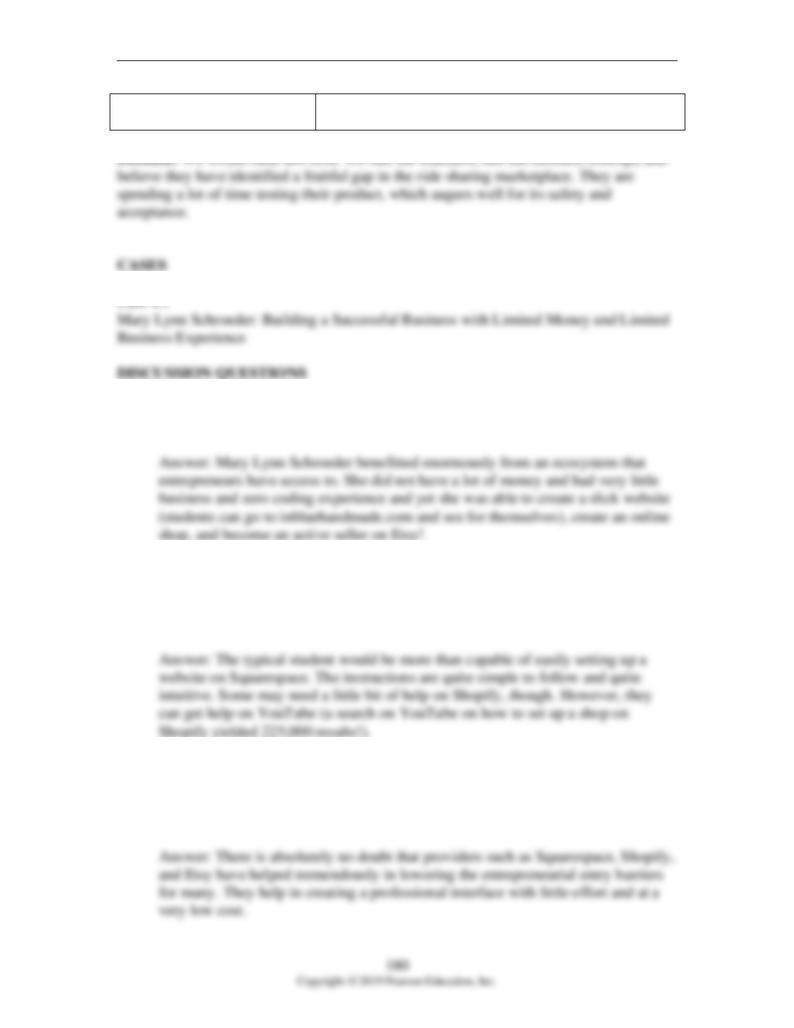
Chapter 8: Assessing a New Venture’s Financial Strength and Viability
Average Score
4.0/5.00
8-32
What can a first-time entrepreneur, who may have a good idea but not much
money or business acumen, learn from Mary Lynn Schroeder’s experience?
8-33
To what degree do you think you’d be capable of building a website on
Squarespace and setting up an online store on Shopify? If you don’t think you’re
capable of either of these tasks, what can you do now to obtain the necessary
capabilities?
8-34
To what degree do you believe ready-made platforms like Squarespace, Shopify,
and Etsy have contributed to the entrepreneurial ecosystem in the United States
and abroad? To what degree could you envision using one or more of these
platforms if you launched a business of your own?

Chapter 8: Assessing a New Venture’s Financial Strength and Viability
8-35
Identify and describe a ready-made platform, like Squarespace or Shopify that is
not a direct competitor of either one of these platforms but fills a similar role in
that it allows an entrepreneur to perform a vital task with very little capital
investment.
8-36
Why do you think this case was placed in the chapter titled “Assessing a New
Venture’s Financial Strength and Viability”?
8-37
Toward the beginning of this case, the following statement appears: “Almost all
small businesses experience cash flow shortfalls.” What is cash flow? Why is cash
flow so critical to an entrepreneurial firm’s success? Why do almost all small
businesses experience cash flow shortfalls?
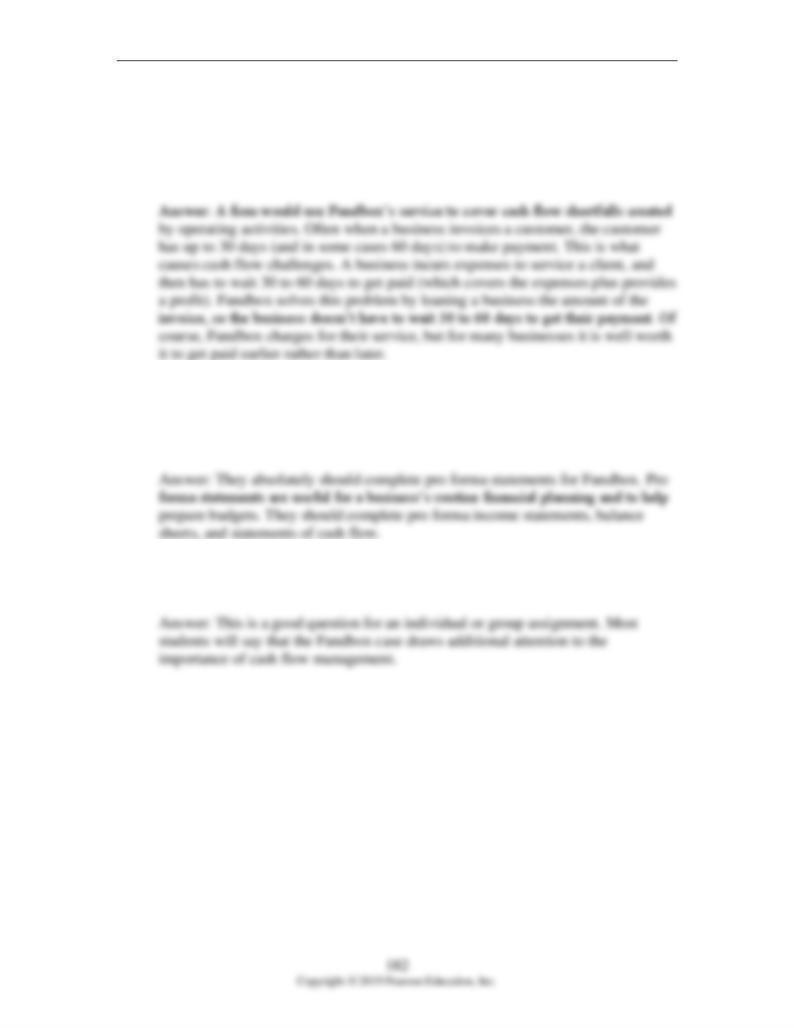
Chapter 8: Assessing a New Venture’s Financial Strength and Viability
8-38
As explained in this chapter, a firm’s statement of cash flows is divided into three
separate activities. Which of the activities from the statement of cash flows would
be affected by a firm’s decision to use Fundbox’s service? What are some of the
potential effects of a small entrepreneurial firm’s decision to use Fundbox on the
components of that firm’s statement of cash flows?
8-39
If Fundbox’s co-founders (Yuval Ariav, Eyal Shinar, and Tomer Michael) were to
ask your advice about the importance of pro forma statements to their firm’s
continuing success, what would you say to them? What pro forma statements
would you recommend the co-founders develop and why?
8-40
As a young entrepreneur, what lessons about the financial management of a firm
can you learn from the actions taken by the three cofounders of Fundbox?